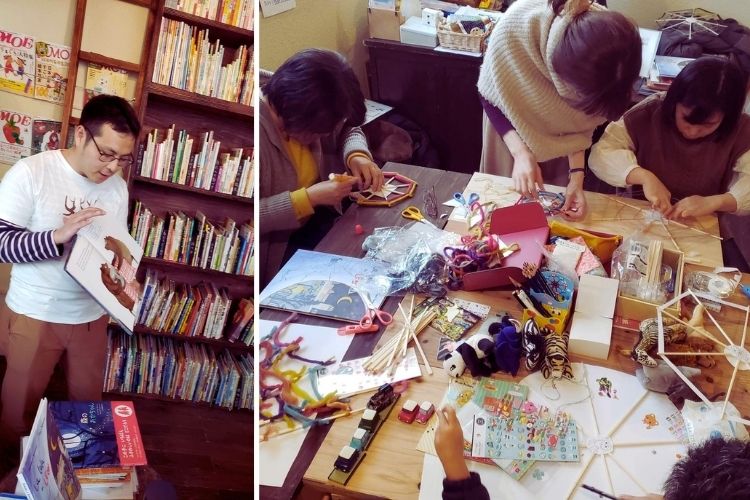
Get the latest updates in your inbox and sign up for more info!
Bookshelves Ahoy! In this Fairtales column, children’s literature expert Petra Paoli takes us around the world exploring independent bookstores for children and young adults.
When exploring Japan’s bookstores, you can find yourself in real ‘cathedrals for reading’. Like the Nakanoshima Children's Book Forest in Osaka. Designed by the famous architect Tadao Ando as a place that imposes no constraints on children’s insatiable curiosity, it is a space of order and beauty, the books displayed in small niches divided into twelve basic theme areas. Children are greeted with a message inviting them to take the time to enjoy books and reading. It is also a reminder to adults to allow children time to nourish their imaginations and self-knowledge.
The great Kengo Kuma created two other architectural marvels to house important libraries: the Kadokawa Museum of Culture in Saitama, a forty-metre building in which books are arrayed in eight-metre high shelves, and the Yusuhara Town Library on Shokoku Island, where people leave their shoes at the entrance in order to enjoy the experience of reading as if in the intimacy of their home. Nor is it uncommon to come across ultra-modern bookshops made up of large buildings with a staggering number of books of astounding variety; places designed to regenerate the body and the mind, stocking the very best publications on offer, and where books - manga in particular – are the stylistic hallmark: places like the Manga Art Hotel, where you can stay overnight in small capsules surrounded by comic book masterpieces.
Alongside these major bookstores catering for readers of all ages, there are also many children’s bookshores, places that exude a deeply-rooted knowledge of their sector, furthering confirming the very real perception one has that stories, good books and illustrations are an integral part of everyday life in the land of the rising sun. Indeed, everywhere in Japan, the shelves of bookstores are full of a range of different picturebooks, all of which have in common their huge visual impact.
So you can imagine my astonishment when I came across the “Libreria Cerbiatto” bookshop in the ancient city of Nara, the sign over the door depicting the endearing animal – a fawn - after which it is named, and on the shelves, an array of Italian books: picturebooks, but also an excellent selection of fiction, all obviously carefully chosen by someone with a deep knowledge of Italian culture.
The bookstore’s founder, Minoru Yomo, lived and studied for some time in Florence and Siena. It was her idea to build a cultural bridge between Japan and Italy with two bookshops, one for children and young people, and the other, the “Libreria Due Porte”, catering for adult readers. Alongside the wide range of Italian books, Minoru also organizes a broad raft of events and tastings.
Bridges capable of bringing our two countries closer together and cultural exchanges are nothing new. Bruno Munari had strong ties with the East, his work and thought enormously appreciated in Japan. Munari’s own Il castello dei bambini a Tokyo, published by Einaudi Ragazzi, sums up his experience in this country.
In an interview, Minoru Yomo described her project and the idea of setting up a bookshop.
When did your project get started? It's quite unusual for a Japanese bookstore to have a catalogue with so much good Italian literature. Why this choice?
The project started about 3 years ago. The aim was to bring Italian culture to Japan through Italian picturebooks and literature. I studied Italian and its literature at university and then as an exchange student in both Siena and Florence as part of my university course in Japan.
I love Italian literature so started this activity. I want to be a bridge enabling cultural exchange between Italy and Japan through books.
I now have two bookstores. One is “Libreria cerbiatto” stocking Italian picturebooks; the other is “Libreria due porte” to introduce adults to Italian books.
What professional skills have you channelled into the project?
I have web bookstores and one physical book store. The bricks-and-mortar store is located in the historical city of Nara - where I’m from - and is managed by 5 people. Nara was the former capital of Japan, so there are many precious temples and shrines from ancient times. The 5 of us select books from different sectors: I choose Italian books; another person, who is an illustrator, selects art books, and so on. Each has his/her own field.
How would you describe your customers?
Almost all our customers love picturebooks and buy them for their children. Other customers are fascinated by Italy and read to study Italian and learn about Italian culture.
What are the specificities of your bookshop?
My bookstore doesn’t just sell Italian books. I also give customers information about the writers and illustrators, with summaries of the content in Japanese. My aim is not only to introduce the books but also to present Italian culture through books. So, it’s essential to provide additional information along with the books. The story behind the story is really important, I think.
I not only want to introduce Italian books to Japan but also Japanese picturebooks to Italy. I put information written in Italian on all the SNS of my store, like Instagram, Twitter and so on. A really popular writer and illustrator is Ms. Michiko Egashira. She has written delightful stories with beautiful illustrations around each of the seasons (Spring, Summer, Autumn and Winter) from the viewpoint of a small girl. This picturebook on the changing seasons is a great way to present Japanese culture.
What kind of selection do you make when you build your catalogue? Do you also have toys or other types of objects?
I put together my own catalogue of Italian picturebooks and children’s literature. At first, I check out Italian publishers like Topipittori, Minibombo and Kite etc. to find good picturebooks. I sometimes ask picturebook writers and illustrators, such as Janna Carioli, Marina Marcolin, Alessandro Coppola, Marinella Barigazzi, Gabriele Clima, Anna Lavatelli and so on, to point out good books. I also check Italian reader reviews on Amazon or IBS. For literature, I often import the books of Italo Calvino, Antonio Tabucchi, Stefano Benni, Dino Buzzati, Alberto Moravia and others because they are indispensable for an understanding of modern Italian literature that has so many good books. Of course, I often introduce and import the books of Gianni Rodari, who is my favourite Italian writer for children and who should be better known by Japanese readers. “L’acca in fuga” and “Essere e avere” from “Il libro degli errori” is one of my all-time favourites.
I have also introduced and sell Italian cakes and candy like Torta Caprese, Brutti ma buoni, and Baci di dama for the same reason: to introduce Italian culture. They are made by an Italian restaurant in Japan run by a woman chef who lived in Florence and studied Italian cuisine and pastry making for several years. Her name is Megumi Sawano and her restaurant is “Favole in tavola”.
How do you engage with families and schools in your area?
I have several connections with junior high school, private schools, child and family services, and an international cultural centre where I organize several events for kids and their families. For example, we presented “Il manuale della Befana” by Anna lavatelli, published by Interlinea at a junior high school, and an Italian girl born in Japan read the book in class explaining the Italian tradition of the Befana. On another occasion, “Che bello!” from Topipittori’s catalogue was read by an Italian lady living in Japan at a meeting at the international cultural centre.
This year has created difficulties that were unimaginable before, forcing each of us to find new solutions. Would you like to tell us about the strategies you adopted?
Last year, I started an online book presentation event with a Japanese translator of Italian picturebooks and also with Italian translators of Japanese books. One of these was Ms. Anna, a university professor of Japanese literature at Turin university. She translated a really famous story in Japan about a fox entitled “Gon, la volpe”. I also have Youtube channels that allow Japanese customers to access lots of Italian picturebooks.
Stay tuned! We’ll be looking at other bookstores around the world.

While not lasting 80 days, we will nevertheless go around the world investigating independent bookstores for children and young adults.
After 8 years working in a specialist bookstore, ceramist and children’s literature expert Petra Paoli founded Odeon Studio, a cultural space for art and illustration. A researcher, she is also involved in education and training and is a Board member of the Accademia Drosselmeier - School for Bookstore Managers and Literature Study Centre.
She also acts as secretary and board member of Alir, the Associaiton of Independent Children’s Bookstores.